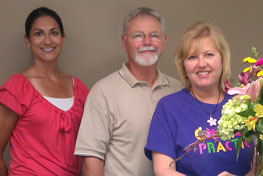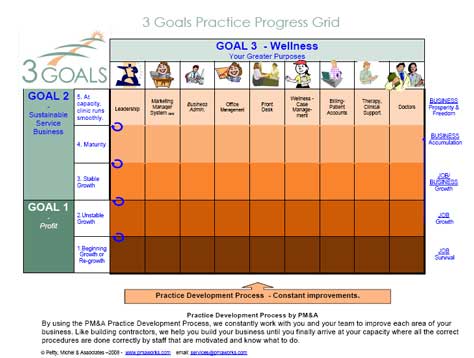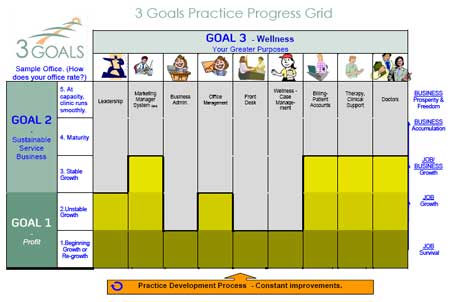Six Steps To A Clinic That Runs Itself
Some chiropractic offices seem to run themselves. The doctor walks in, the rooms are full, and he leaves after the last patient is seen. The staff is efficient and upbeat. The chiropractor takes lots of vacations and can afford to. New patients call in every day.
Isn’t this what we all want: a self-reliant office that is profitable, gets people better, and gives us plenty of time off?
What we don’t want is a doctor-reliant office. You know, the one that requires your constant supervision, your hourly orders, and many hours of extra work. The one where you struggle for new patients and that gives so much stress to you, your staff and family, and in return provides so little profit.
There are not too many self-reliant offices, but they do exist. Maybe you have experienced such a condition in your own chiropractic practice, or seen it. In such an office, there is a lot going on behind the scenes that can go unnoticed.
What are these often overlooked key components that make up a self-reliant office? Listed below are six of them that you can use to make your office self-reliant.
1. Staff. You have to have the right staff in the right positions.
They also have to be trained and have the feeling of being included in the overall growth and decision making of the office. Otherwise, they can become apathetic, as their views have no weight and so why should they have any views or suggestions? This is an important reason to have staff meetings, by way. They help include everyone in the management of the office and helps make employees feel like it is their clinic too.
By the way, staff also include any vendors that support you and your business, from accountants, coaches, and consultants, to computer support providers and lawyers.
2. Procedures. As Aristotle said, “We are what we repeatedly do.” This is a subtle but huge secret of the successful offices: they do what they do consistently. Over and over again. They don’t change. Sometimes they need to, and when they don’t, their numbers start to crash.
This applies to staff, patients, and you personally. Brushing your teeth, exercising, getting regular adjustments yourself, all should be regular. Success is the sum of consistent good actions. Make sure your office has procedures that are in writing, that are referred to, and that get reviewed at least every three months.
3. Monitors. Baseball teams have a scoreboard. Golfers have a scorecard. Weight watchers have a scale. Business owners and investors have financial statements. Doctors have outcome studies, patient testimonials, practice statistics, and patient surveys. Managers have all these.
It is hard to tell what is going on by “feelings.” Sometimes, these are very useful, but emotions can lead to incorrect conclusions. An annoying associate may have very high numbers and great patient testimonials, referrals, and outcomes. On the other hand, a very sweet front desk assistant may not be able to schedule patient appointments.
Without accurate scores, your clinic team won’t know whether they are coming or going, rising or falling, and may not even care.
4. Owner’s Role. The doctor has a number of roles. Mostly, doctor. Doctoring patients is what the office is ALL about. However, the doctor also has the role of the owner, and this has just a few, but very vital, duties that must be fulfilled.
Actually, it is just one duty. Here it is:
The owner has to be able to make everyone feel like an owner too.
What would the staff member do about a low new patient count if it were their office? What would the associate doctor do about staff training, promotions, and overhead? What is the greater mission of the office and why? If the employees could share in the burden of responsibility, the pressure of performance, the sense of duty, and in the vision of the future, the clinic would drive itself.
The owner has to put energy into the office and provide leadership. He or she also has to make everyone feel like a leader.
5. Management. If all the earlier points are doing well, then there should not be a need for a lot of management. Management is mostly communication and coordination. This includes regular reviews of performance monitors, procedures, and plans that allow everyone to know where they stand and what should be done to reach the next level.
6. Professional Service and Patient Care. The only reason there is management, owners, monitors, procedures, and staff, THE ONLY REASON, is for that one patient that comes in to see you when they come in to see you. All else is minor.
It is everyone’s job to continually work on improving the quality of services they render to the patient. Improving your craft as a doctor, educator, therapist, hostess-front-desk-patient-service coordinator, reimbursement specialist, etc., is the most important component in a successful office.
You see, patients can tell. What distinguishes you from others is the level of your intention to care for them. Give the 100%, and you will keep them and get their family and friends to come in as well. Give them less and they will be looking elsewhere. Just like you do when you visit any service professional.
—-
These ingredients can be applied to different departments in the office, such as the front desk, billing and collections, adjusting, therapy, diagnostics, and marketing. For example, do you have marketing procedures that your staff understand and apply regularly? Do you monitor not only the number of your new patients, but where they come from? Is your marketing well managed, and do you work to improve its quality?
You can grade your office in terms of how complete each one of these components are present. (See chart.) You have to be honest and face the fact that many times, not all areas of your office are in the best condition. When this occurs, you will have to get busy and improve things. But the reward of a well-built business is time off and profit. The penalty, of course, is no time off and no profit.
In The 4-Hour Work Week, author Tim Ferris discusses how, in theory, one can earn more and work less. Perhaps a bit unreal, especially for a doctor, it lays out ideas on how, and why, you can cut your workload. Similarly, the by now well-known E-Myth by Michael Gerber, discusses the importance establishing systems (a fancy word for procedures) that will help you do the work.
We have a proprietary term for this which we call The PM&A Practice Development Process. We have been helping doctors achieve this goal for nearly 20 years, and is a core focus of our services.
If you are willing to do what it takes to get all six of these components in place, in time you can be receiving your practice statistics via cell phone while you are sipping lemonade along the beach in Tahiti.















